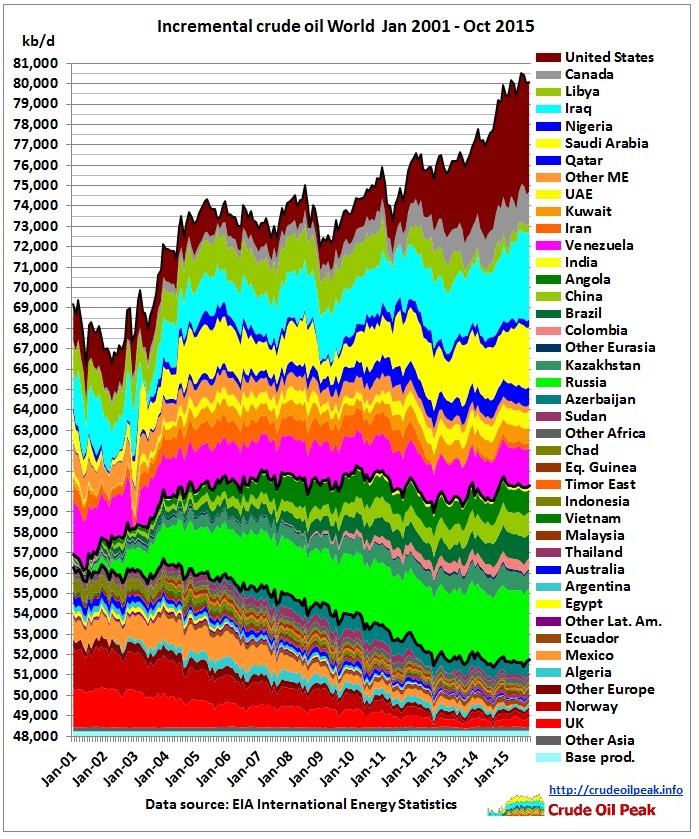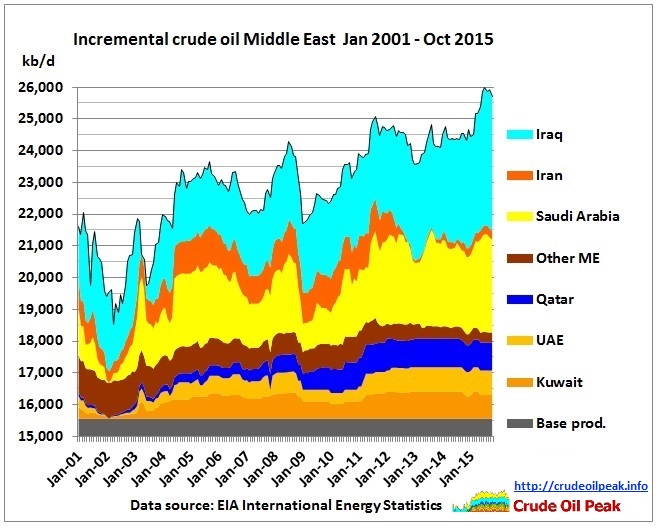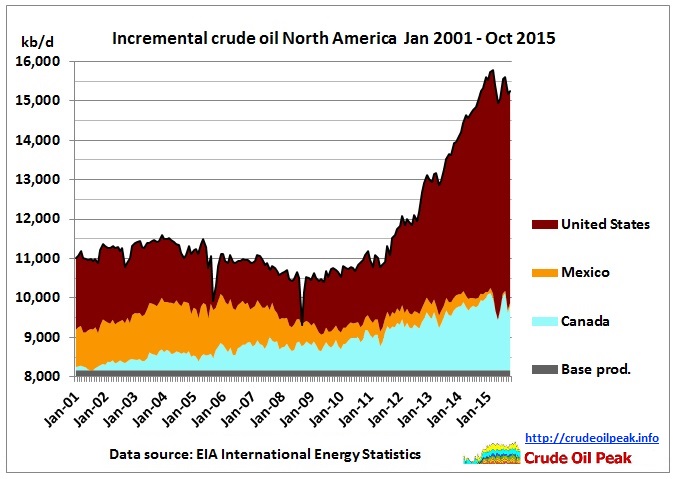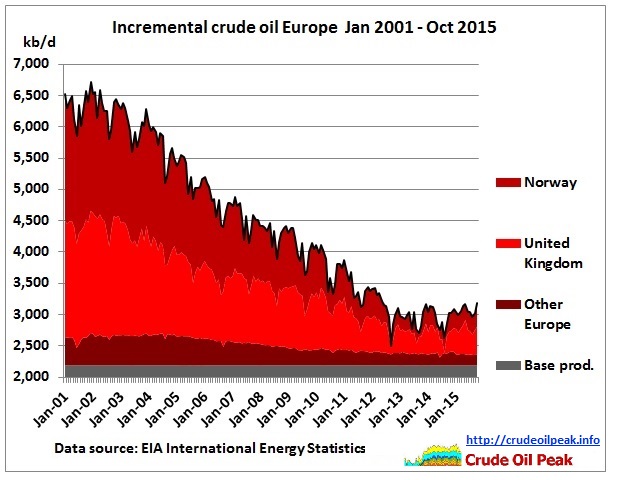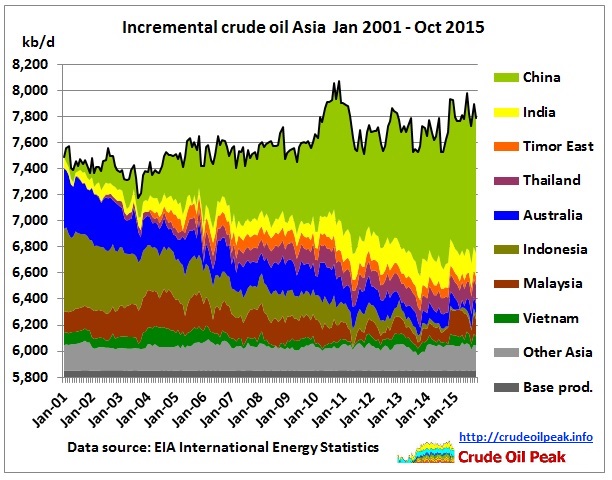After a delay of several months the US Energy Information Administration has published the latest international energy statistics for October 2015
This is an opportunity to update crude oil graphs
http://crudeoilpeak.info/latest-graphs
Fig 1: World’s incremental crude oil production
How Fig 1 is created: for each country, the minimum production in the period Jan 2001 (original IPS start month) to October 2015 is taken (=base production) and deducted from the country’s total production, giving the incremental production which is then stacked in a way that allows to interpret which changes occurred. The stacking order is:
(a) Base production
(b) Countries with growing production
(c) Countries with flat, peaking or declining production
(d) OPEC and Middle East countries
(e) Canada (mainly tar sands)
(f) United States (mainly shale oil)
The numbers denote following events:
(1) Venezuela strike
(2) Iraq peak oil war
(3) Saudi production declines
(4) High demand for China Olympic Games
(5) Iran sanctions introduced
(6) Iraq reaches pre-war production level
(7) US shale oil boom takes off
The red horizontal line is the maximum crude oil production level in May 2005 (the Katrina year). We can see that almost all additional oil produced now above that level is US shale oil. In other words: without US shale oil (which required cheap money from quantitative easing), the world would be in a deep oil crisis.
The grey line shows the September 2005 production level outside the US and Canada. The graph shows that the October 2015 production level is only slightly higher than in 2005, possibly within the accuracy of statistics.
We can therefore confidently say that growth of the world economy managed to make itself completely dependent on unconventional oil from the US and Canada.
The oil price in October 2015 of $48 is the same as the average oil price in the first 5 months of 2005. Many will call this a price cycle and not worry. But in oil depletion there are no cycles, there is only a race to the bottom of the barrel. Since 2005, the world has gobbled up more than 300 Gb of crude oil and that was definitely oil which was easier to extract than what lies ahead of us.
In the next graph, we swap the groups of growing and declining countries
(a) Base production
(b) Countries with flat, peaking or declining production
(c) Countries with growing production
(d) OPEC and Middle East countries
(e) Canada (mainly tar sands)
(f) United States (mainly shale oil)
Fig 2: World’s incremental crude oil production
Fig 2 highlights two wedges bounded by black lines. After the Mexico peak 2004-2006 the growing group headed by Russia could just about offset decline in the North Sea and many other countries which had peaked or were peaking. We can say that without Russia’s production increase of 2.5 mb/d between 2000 and 2005 the world would have plunged into a deeper crisis in 2005 -07.
Fig 3: Middle East incremental crude production
The Middle East graph shows the usual chequered production history. Notable is the recent production increase in Iraq, finally, more than 10 years after the Iraq war. Bush and Cheney could not imagine in 2002 that oil prices would go to such levels that the already known fracking technology would be employed in shale oil formations. It is an irony of history that the Iraq production increase coincided with the shale oil boom and contributed to bring oil prices down and/or keep them low. After the lifting of sanctions on Iran it is expected that maybe an additional half million barrel of oil will hit the markets.
As for Saudi Arabia, the following post gives a good description
2/3/2011 WikiLeaks cable from Riyadh implied Saudis could pump only 9.8 mb/d in 2011
http://crudeoilpeak.info/wikileaks-cable-from-riyadh-implied-saudis-could-pump-only-9-8-mbd-in-2011
Fig 4: North America incremental crude production
It took until 2012 that the Mexican oil peak was offset. North America seems to peak now.
Fig 5: Latin American incremental crude production
Venezuela’s oil production is suspiciously flat for years on end. It prominently comes into the picture in this graph because production dropped by 80% in early 2003, resulting in a huge incremental component. Argentina has definitely peaked and Ecuador is on a bumpy plateau for a decade now. Brazil’s pre-salt exploitation will be interesting to watch with lower oil prices.
Fig 6: Europe oil decline
Oil prices started to go up when North Sea oil had peaked in 2001
Fig 7: Former Soviet Union incremental crude production
The long awaited Russian oil peak is shaping up.
Fig 8: Africa incremental crude production
Algeria and Sudan have peaked. Libya remains a wild card. While writing this article, a military jet came down near Benghazi. In January, fights with ISIL set fire to oil tanks at Es Sider and Ras Lanuf.
Fig 9: Asia incremental crude production
Asia’s production profile is dominated by Indonesian and Australian declines and Chinese growth which, however, seems to have petered out in 2015. In any case these increments were/are tiny compared to the additional consumption of an assumed, much touted, future middle class numbered in the hundreds of millions.
10/6/2015 China’s offshore CNOOC started to peak in 2010
http://crudeoilpeak.info/chinas-offshore-cnooc-started-to-peak-in-2010
Fig 10: All together now.
It should be quite clear that the Middle East will play a pivotal role once US shale oil production goes into decline.
Summary and conclusion:
Outside the US and Canada, the world is in peak oil mode for more than 10 years now. There are many events which have brought about this bumpy production plateau. The sequence of these events has never allowed oil production to grow much over a longer time. We have seen the predicted negative feedback loops when oil production gets harder and more expensive. The end result of this phase is a weakened financial system with more debt and many government budgets in deficit.
The response to peaking conventional oil production was money printing and unconventional oil. In typical US style huge amounts of material, equipment and labour were mobilised to extract shale oil from tight rocks, a last resort after US production had declined since 1970. Skilfully designed propaganda of the oil industry employed the media to spread the news of an energy revolution. The objective of becoming independent of oil imports and thus beat OPEC excited the whole US nation. But it was overdone. The light shale oil – not your average crude oil – could not all be absorbed by US refineries and ended up in inventories. In a strange way, market forces did not work.
Later than expected US shale oil is peaking now. The latest case is the Chesapeake stock slump. If oil prices stay low for a longer time, oil production will ultimately go down and 2015/16 may be the global peak. Price spikes will be certain, further damaging the financial system. And then we have the Middle East. The sinkhole around Syria is widening month by month. There is no way a revived US shale oil industry could compensate for any losses when fights start in the Persian Gulf.




